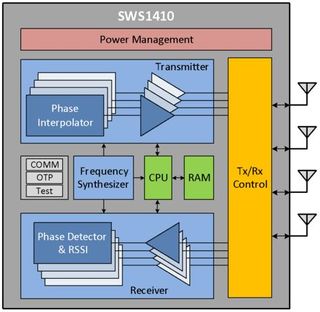Cota Wireless Charging Gets Transmitter, Receiver Chips From Ossia, Si-Ware Systems Partnership

Ossia, the company behind the Cota "30-foot range" wireless charging technology, announced two transmitter and receiver chips developed by the Cairo-based Si-Ware Systems. The transmitter chip is called SWS1410m and the receiver chip is SWS1420.
According to IHS Research, wireless charging is seeing increased demand for mobile or IoT devices, and it's expected to grow to $8.5 billion by 2018. Ossia's Cota can enable many of these devices to charge within a room from a single wireless charger, without needing to put each device on a fixed pad (such as with Qi technology), or even in the relative area of the charger (as with Airfuel's magnetic resonance charging).
MORE:
- Wireless Charging Adoption Gets A Nudge As A4WP, PMA Rebrand As 'AirFuel Alliance'
- NuCurrent Combines AirFuel, Qi Wireless Charging Technologies Into Single Multi-Mode Smartphone Antenna
Cota wireless chargers will be able to send around 5W of power to devices initially, but the chargers can be tweaked in the manufacturing stage to send up to 10W of power to multiple devices. The devices can charge up to eight devices simultaneously, but the 5-10W of power will be split between them.
This is less of an issue with a technology such as Cota, because with Cota you won't have to worry about having a specific "charging time" set aside for devices -- they can charge continuously while they are in the 30-foot range of a Cota wireless charger.
According to Ossia, the chargers are completely safe for humans, even if there are multiple Cota chargers around. The power passed wirelessly by the transmitter will actively avoid any obstacles, including humans.
“Wireless charging solutions and going cable-free are changing the way we use and interact with everyday devices, opening the door for a host of new applications and consumer technologies," said Hatem Zeine, chief executive officer, Ossia. "SWS had the deep understanding of our needs and was able to deliver an innovative silicon chipset in less than one year that was operational in a real environment. They were highly responsive, worked with us closely through all development phases, and were committed to offering a complete approach, from concept to manufacture," he added.
Stay on the Cutting Edge
Join the experts who read Tom's Hardware for the inside track on enthusiast PC tech news — and have for over 25 years. We'll send breaking news and in-depth reviews of CPUs, GPUs, AI, maker hardware and more straight to your inbox.
The SWS1410 Cota transmitter is a MIMO transceiver that implements two main functions within the Cota system: detecting the location of the receivers from one or multiple devices, and transmitting the focused power to those devices through a multipath radio frequency in the range of 2.4 GHz (which the company claimed works nicely with other Bluetooth devices and doesn't interfere with them).

The SMS1420 receiver also implements functions in the Cota system: receiving, rectifying and converting RF power into DC current to charge the devices' batteries, and transmitting a synchronized beacon signal to the charger to help it locate where it should send the power. The receiver can support a wide range of RF power delivery, from 100mW to 10W.

Ossia believes that its long-range wireless charging technology will eventually replace, rather than integrate with, other technologies (the way we've seen some multi-mode wireless charging chips lately). The company claimed Cota offers most of the charging capabilities of other technologies, but with much higher convenience. With Cota, you won't have to think about when you need to charge your devices, because they could always be drawing power from Cota chargers around you.
MORE:
- Samsung's Solution To Wireless Charging Fragmentation: Use All The Standards
- Mediatek Combines All Three Wireless Charging Standards Into One ASIC
The SWS1410 transmitter ASIC chip will start sampling in Q1 2016, while the SWS1420 receiver chip will begin sampling in Q2 2016. The chips could be seen in shipping devices by early 2017.
______________________________________________________________________

Lucian Armasu joined Tom’s Hardware in early 2014. He writes news stories on mobile, chipsets, security, privacy, and anything else that might be of interest to him from the technology world. Outside of Tom’s Hardware, he dreams of becoming an entrepreneur.
You can follow him at @lucian_armasu. Follow us on Facebook, Google+, RSS, Twitter and YouTube.
Most Popular





